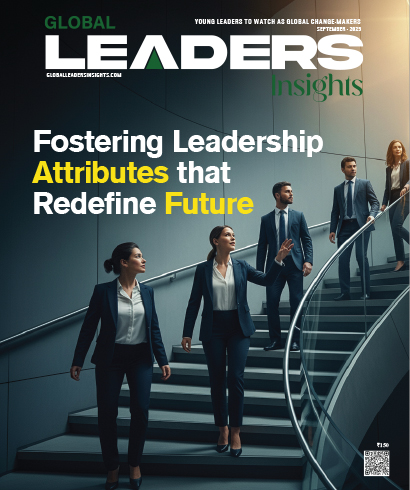The New Frontier of AI-Driven Commerce
By Global Leaders Insights Team

In an exclusive conversation with Global Leaders Insights, Katja Forbes, Executive Director & Head, Client Experience, Insights and Development, CIB, Standard Chartered, discusses how AI-driven commerce is transforming global markets. She reveals how AI is evolving into an autonomous market participant — “machine customers” that negotiate, purchase, and evaluate suppliers. Forbes highlights a shift toward data-driven trust and transparency, where being machine-readable defines competitiveness. Advocating a human-centred approach, she envisions AI as a force that amplifies human values, empowers SMEs, and drives inclusive, ethical growth.
How is AI transforming traditional supply chains and what new economic dependencies might emerge as a result?
We hear a lot about AI optimising supply chains but there’s something else more interesting happening where AI is actually becoming a supply chain participant…as ‘machine customers’ or AI that buys, if you like. For example, Walmart has been closing nearly 70% of their vendor contracts using AI procurement platforms, with no human needed to intervene. These are autonomous buyers that negotiate terms, evaluate proposals, and make purchasing decisions at scale.
Traditional supply chains were designed around human decision-making rhythms, like quarterly reviews, annual contracts, relationship-building. Machine customers, or AI that buys if you like, operate differently. They evaluate suppliers in real-time, switch vendors based on performance data, and optimise continuously.
This creates new economic dependencies. Suppliers must now be “machine-readable” so their pricing, capabilities, and compliance credentials need to be structured data that algorithms can parse. Companies that can’t present themselves in machine-readable formats risk becoming invisible to AI buyers, regardless of quality.
The competitive advantage is shifting from “who you know” to “how discoverable and trustworthy you are to algorithms.” Organisations that understand they’re serving both human and machine customers will thrive.
Also Read: 1.2B Bank Accounts, Yet Many Still Excluded, What’s Missing?
In what ways can AI personalisation engines enhance customer experience without crossing ethical or privacy boundaries?
We’re about to serve two completely different types of customers simultaneously, and the ethics look different for each.
AI agents are emerging as intermediaries buying on behalf of humans. Visa’s Intelligent Commerce bot transacts using your card with parameters you set. Delegated agents handle grocery ordering. These agents need deep access to your preferences, finances, and personal data to serve you effectively.
The ethical boundary is about trust architecture. When my AI agent negotiates with your business, three things must be clear:
Explicit value alignment: The agent must be configured with my actual values, not just “find the cheapest,” but “find suppliers who match my sustainability requirements or other core values I can explicitly state.” This requires businesses to encode their values in machine-readable formats.
Verifiable trust signals: Instead of marketing claims, businesses must provide auditable evidence that could take the form of compliance certificates, performance dashboards, verified credentials. My agent evaluates data, not emotional appeals.
Human oversight boundaries: Clear protocols for when agents escalate to humans. Medical treatments, major financial commitments, irreversible choices should require human confirmation regardless of AI confidence.
The companies getting this right aren’t asking “how much personalisation is too much?” They’re asking “how do we build trustworthy systems that respect both human autonomy and the agents representing them?”
What role will AI play in reshaping employment, reskilling needs, and workforce dynamics across industries?
AI agents are already making purchasing decisions autonomously, handling vendor selection, contract negotiation, and procurement that used to require human judgement. This transforms roles on both sides of the transaction.
On the buying side, procurement officers are moving from tactical negotiation to strategic supplier relationship management, designing the parameters and values that guide autonomous purchasing systems.
On the selling side, sales and marketing teams face a new reality: their customer might be an algorithm. This means evolving from emotional persuasion to “signal clarity” and making offerings discoverable in structured formats. Marketing shifts from “trust our brand” to “here’s the auditable proof.”
The reskilling need is urgent. Customer experience professionals must learn to design for algorithmic customers alongside human ones by making value propositions machine-readable, building trust through APIs and performance metrics, and measuring success when your “customer” has no emotions.
The emerging workforce dynamic: humans focus on strategic configuration, ethical oversight, and edge cases whilst AI agents handle high-volume transactions. The invaluable skills become systems thinking, ethical reasoning, and translating between human intent and machine logic.
By 2030, Gartner predicts machine customers will control $30 trillion in purchasing decisions. Companies preparing their workforce for this hybrid reality will have decisive advantages over those pretending the customer will always be human.
Also Read: The Shift from Reactive to Proactive Employee Relations
How can AI help small and medium-sized enterprises (SMEs) compete in a market increasingly dominated by data-rich global giants?
Machine customers could be the great equaliser for SMEs if they move quickly. AI agents making purchasing decisions don’t care about your company size, advertising budget, or business longevity. They evaluate you on merit, wanting to know can you deliver what you promise, and can you prove it?
This disrupts traditional advantages of scale. A small manufacturer in rural Australia or a specialised supplier in an emerging market can compete head-to-head with global brands, because machine customers evaluate actual performance rather than brand reputation.
There are some specific advantages for SMEs:
Performance over prestige: A small business with 99% uptime and transparent service levels can win against an inconsistent global brand. Track record speaks louder than marketing budget.
Niche expertise wins: AI procurement platforms excel at finding specialised suppliers humans might overlook. If you’re exceptionally good at something specific, you can be discovered by buyers worldwide who need exactly what you offer.
Speed and agility: SMEs can adapt faster. Whilst large enterprises navigate bureaucracy, smaller companies can quickly make their offerings accessible to AI agents.
Lower barriers to global markets: I’ve researched this in South Africa, where companies like Yoco are bringing digital payment to small businesses and the informal economy for the first time. Eighty per cent of their customers have never taken a card payment before. A roadside vendor who can accept digital transactions and provide clear product information could suddenly serve customers globally if we handle agentic commerce inclusively and provide them equitable access to the infrastructure.
Reduced relationship gatekeeping: Traditional B2B sales required expensive relationship-building. Machine customers evaluate data, removing barriers that historically favoured companies with big sales budgets.
This opportunity is only real if machine customer technology doesn’t require sophisticated infrastructure to participate. We need accessible standards that work for businesses at every level. Done right, this democratises global market access. The fundamental shift favours SMEs as, in a world where algorithms evaluate merit over brand power, smaller players with real expertise and reliable delivery can get a fair shot.
What do you envision AI-driven commerce will look like in the next decade—and how can we prepare for the societal shifts it will bring?
The transformation is already underway, and it’s accelerating faster than most organisations realise. Your AI agent will manage routine purchases like ordering groceries, scheduling vehicle maintenance, paying bills within boundaries you set. It will evaluate suppliers based on your values which can include sustainability credentials, labour practices, local business preferences. In B2B, procurement platforms will autonomously manage supply chains, continuously evaluating vendor performance.
Gartner projects that by 2030, machine customers will control trillions in purchasing decisions. The AI agent market itself is expected to exceed 200 billion dollars by 2035. Rather than distant future speculation, this is actually strategic planning horizon for businesses today.
It requires a fundamental restructuring of market participation. Well-designed agent systems could make markets more accessible. Small suppliers compete globally. Information asymmetry decreases when agents evaluate options transparently.
However, without proper governance, machine customers could accelerate market consolidation. Pure optimisation for price and efficiency creates race-to-bottom dynamics regardless of broader social value. Millions of jobs in sales, procurement, and customer service will transform. We need massive reskilling programmes now.
And trust infrastructure is crucial. When an AI agent makes a bad decision on your behalf, selects an unreliable supplier, misses dietary restrictions, optimises for short-term cost over long-term value, who’s responsible? Preparing requires regulatory frameworks ensuring transparency and human oversight, standards for machine-to-machine commerce, education systems preparing workers to collaborate with AI, and ethical guidelines for agent configuration.
My biggest concern is the potential for increased inequality if only the wealthy afford sophisticated AI agents whilst others settle for basic automation or nothing at all. We need to think about AI agents as public infrastructure, not luxury products.
Also Read: AI Fails in Contact Centres due to Talent Crunch
What advice would you give to businesses or professionals seeking to successfully integrate AI into their commerce strategies without losing the human touch?
The near term future isn’t human OR machine customers. It’s human AND machine customers, often in the same transaction.
To maintain humanity whilst embracing algorithmic commerce we need to design for the hybrid journey. When someone’s AI agent evaluates your offerings, it needs structured data and APIs. When that person confirms the decision, they need clear explanations and human-readable information. Design for both.
Keep humans in the loop for what matters by defining clear escalation protocols. When stakes are high, when values are ambiguous, when outcomes are irreversible, design these boundaries thoughtfully.
Customer service, sales, and CX professionals are becoming more important, not obsolete so train them thoughtfully. Their roles are changing from transaction execution to strategic design, ethical oversight, and handling complex cases AI can’t manage.
Understand how trust works when your customer is an algorithm. It’s about consistent performance, transparent data, verifiable credentials, and reliable delivery. Your trust architecture is crucial here. Genuinely serve both types of customers. Ask: “How can we make this easier for an AI agent to evaluate us?” and “How can we ensure the human (or business made up of humans) behind that agent is genuinely better off?”
The businesses that will thrive see machine customers not as threats to humanity but as tools that amplify human values and choice. Your AI agent should make you more human, more able to act on your values, more empowered to make informed choices.
The human touch in AI-driven commerce must ensure algorithmic efficiency serves human flourishing, not just corporate optimisation. Get that right, and both your human and machine customers will choose you.
Further Reading
For a deeper exploration of this transformation, check out the author's upcoming book “Machine Customers: The Evolution Has Begun – How AI that Buys is Changing Everything,”


